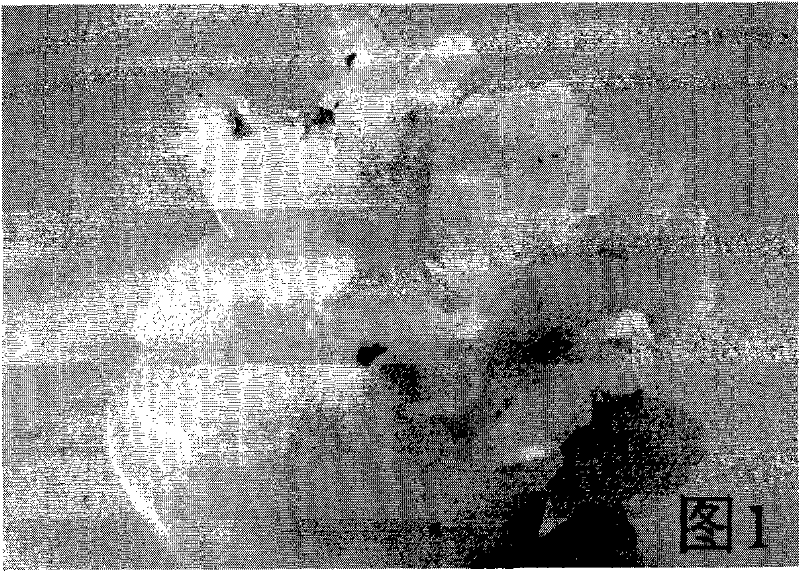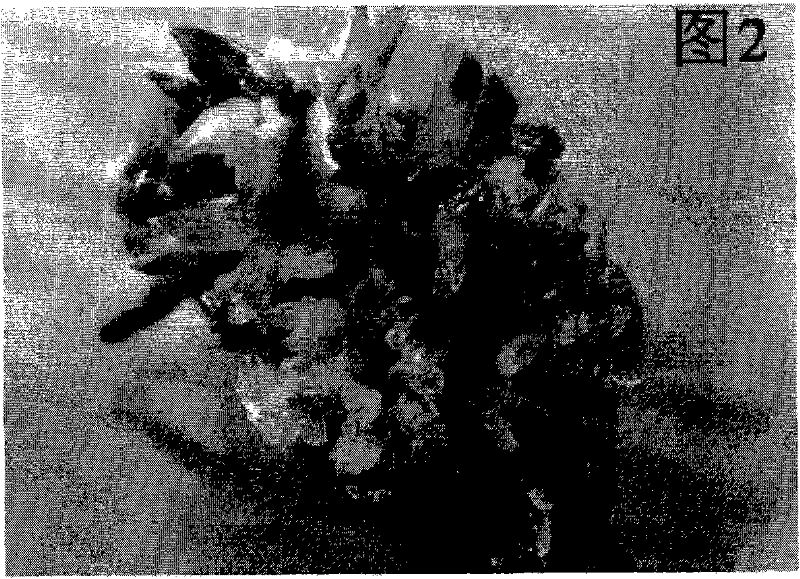Method for cultivating sweet sorghum tissue and special culture medium thereof
A technology of sweet sorghum and culture medium, applied in the field of sweet sorghum tissue culture, method and its special medium, which can solve the problems of low regeneration efficiency and difficulty in hardening seedlings, and achieve high regeneration efficiency, normal shape and good genetic stability Effect
- Summary
- Abstract
- Description
- Claims
- Application Information
AI Technical Summary
Problems solved by technology
Method used
Image
Examples
Embodiment 1
[0051] Embodiment 1, acquisition of regenerated seedlings of sweet sorghum and statistical observation thereof
[0052] 1. Obtaining regenerated seedlings of sweet sorghum
[0053] 1. Preparation and statistical observation of callus
[0054] 1) Pretreatment of explants
[0055] The young panicles (Phase IV-VI of young panicle differentiation) of sweet sorghum variety Keller (Sorghum bicolor (L.) Moench 'Keller') were used as explants.
[0056] The specific operation of pretreatment: first select the robust sweet sorghum plants, take the sweet sorghum young ears with leaves less than 10cm in length, add detergent to clean the dust on the surface of the material, rinse it under running tap water for about 30 minutes, and then put it on Carry out disinfection in the ultra-clean workbench, first sterilize with 75% (volume percentage) ethanol for 2-3 minutes, then sterilize with 0.1% (mass percentage) mercury chloride for 10-15 minutes, and finally wash with sterile water for 4 -...
Embodiment 2
[0098] Embodiment 2, the acquisition of sweet sorghum regenerated seedlings
[0099] The difference between this embodiment and embodiment 1 is the callus induction medium, and all the other steps are identical:
[0100] The callus induction medium of the present embodiment is obtained by adding hydrolyzed casein, proline, polyvinylpyrrolidone (PVP), vitamin C, 2,4-D, sucrose and agar on the basis of MS basic culture medium Medium, wherein the final concentration of hydrolyzed casein is 0.5g / L, the final concentration of proline is 0.6g / L, the final concentration of PVP is 100mg / L, and the final concentration of vitamin C is 10mg / L, 2, The final concentration of 4-D is 2.0mg / L, the final concentration of ZT is 1.0mg / L, the final concentration of sucrose is 30g / L, and the final concentration of agar is 8g / L; The pH of this medium is 5.8; Wherein MS The solvent of the basic culture medium is water, and the solute is shown in Table 1.
[0101] The experimental results are shown...
Embodiment 3
[0104] Embodiment 3, the acquisition of sweet sorghum regenerated seedlings
[0105] The difference between this example and Example 1 is that the callus induction medium used is different, and the rest of the steps are identical:
[0106] The callus induction medium in this example is: on the basis of MS basic culture medium, the medium obtained by adding hydrolyzed casein, proline, PVP, vitamin C, 2,4-D, ZT, sucrose and agar , where the final concentration of hydrolyzed casein is 0.5g / L, the final concentration of proline is 0.6g / L, the final concentration of PVP is 10mg / L, the final concentration of vitamin C is 10mg / L, 2,4-D The final concentration of ZT is 2.0mg / L, the final concentration of ZT is 2.0mg / L, the final concentration of sucrose is 30g / L, the final concentration of agar is 0.8%; the pH of this medium is 5.8; The solvent is water, and the solute is shown in Table 1.
[0107] The experimental results are shown in Table 7. As can be seen from Table 7, compared ...
PUM
 Login to View More
Login to View More Abstract
Description
Claims
Application Information
 Login to View More
Login to View More - R&D
- Intellectual Property
- Life Sciences
- Materials
- Tech Scout
- Unparalleled Data Quality
- Higher Quality Content
- 60% Fewer Hallucinations
Browse by: Latest US Patents, China's latest patents, Technical Efficacy Thesaurus, Application Domain, Technology Topic, Popular Technical Reports.
© 2025 PatSnap. All rights reserved.Legal|Privacy policy|Modern Slavery Act Transparency Statement|Sitemap|About US| Contact US: help@patsnap.com



